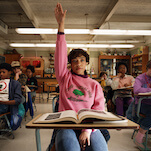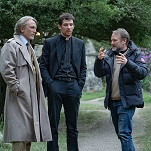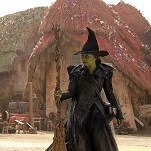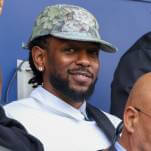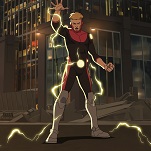3) It’s hard to pick just one scene from Brian De Palma’s career, but let’s go with the shattering conclusion of Blow-Out. (Needless to say, this clip is as spoilery as it gets.) De Palma is still lazily tagged as a Hitchcock imitator, but even Vertigo doesn’t match the impotent mea culpa of John Travolta’s attempt to rescue Nancy Allen from the clutches of politically connected hit man John Lithgow. The crushing irony of the final scene brings the movie full circle and serves as a self-lacerating reminder of the limits of the filmmaker’s power. Vanquished by life, Travolta’s character retreats into art, condemned to replicate his failure every time the projector whirrs.
3) My No. 1 favorite movie scene—the one scene that always makes me stop the DVD and watch it at least three times—is the scene from Mean Streets when Robert De Niro, as all-time great shameless fuckup Johnny Boy, walks into a bar as “Jumpin’ Jack Flash” blasts on the soundtrack. It doesn’t sound like much, but the synthesis of the Stones and the blood-drenched lighting makes this the single greatest representation of doomed, sexy-as-hell cool ever.
Claire Zulkey
I feel a little embarrassed at my standout scenes, because they’re rather frivolous and silly, but I think a funny or over-the-top scene is more memorable to me in the long run than a scene that’s, well, good. Here are three of mine:
1) I am always transfixed by Sally Field’s epic meltdown scene in Steel Magnolias. Spoiler alert: Her daughter dies after struggling with diabetes, and after the funeral, Field loses her shit in front of her friends, going from quiet mourning to screeching, panicky, and sobbing within a few precious minutes. Part of me knows that it’s blatant scenery chewing estrogen-bait: “It was supposed to be meeee!!” is almost required dialogue for any movie where a parent dies before a child. But even though I know it’s ridiculous I still watch the whole damn scene when it’s on and get choked up each time. I feel like a chump but I can’t help myself.
2) Paul Rudd’s cafeteria scene in Wet Hot American Summer, I argue is what turned him over, in the public eye, from a cute bland rom-com actor to a comedian. He’s so ridiculous, so petulant, so stupid in this scene, plus employs such great physical comedy, with the little added bonus that we’ve all felt the way he does at times when we have to do something we don’t want to:
3) Finally, I don’t know if this counts, because it’s several scenes and not just one, but I think Rosalind Russell steals every scene that she’s in in George Cukor’s The Women. If roles like that were written more often, Hollywood would be a much more interesting place for women. She’s gorgeous, comedic, statuesque, physical, pathetic, and evil all at once. She’s a total bitch package, and I can never get enough.
Todd VanDerWerff
1) I have a weird affection for the America of the 1940s. Because of where I grew up, I have a huge affection for small-town stories. It’s A Wonderful Life, then, is like a direct shot of exactly what I like, right to my heart. Everybody says Wonderful Life earns its sentimentality with its dark, dark first four-fifths, and yeah, that’s true, but there’s also a general sense that a place like Bedford Falls—a place simultaneously heartwarming and constraining—doesn’t actually exist. But here’s the thing. I grew up in Bedford Falls, pretty much. When I was a little kid, we still had a fairly thriving Main Street in my little burg. We still had a guy who would sell you eggs, and only eggs, for God’s sake. But I always felt that urge to get out, that fear that I would be trapped. And of course, I met a girl, and even though I tried to keep away from her, because I could feel that pull of getting in way, way over my head, it was undeniable. I couldn’t avoid it. So there is pretty much no way I can’t single out the phone scene from Wonderful Life. It’s simultaneously one of the most romantic and most heartbreaking scenes I’ve ever seen. He can’t escape her orbit, she can’t escape his, and that means both of them are going to have to give some things up. “I wanna do what I wanna do,” George Bailey says, and it’s one of the most plaintive cries in American film. It’s Jimmy Stewart at his best, in a film that’s as much about one nation’s unease with its new power post-World War II as it is about anything else. But here’s the thing: I got out of Bedford Falls, and I got the girl. I live a great life in the big city, and I can pretty much go wherever I want, whenever I want, because I’m a writer. It’s everything I wanted out of life and more. But when I go home—back to Bedford Falls—everybody else has left, too. The egg guy has closed up shop. Main Street is shuttered. It’s a town just barely hanging on, a place that could use more George Baileys. And a little part of me still hopes I’ll end up trapped.
2) My mom used to play the music from Lawrence Of Arabia on the piano when I would fall asleep on warm summer nights. So I was predisposed to like the film. But when I finally saw it—and particularly when I was lucky enough to see it on the big screen at Milwaukee’s own Times Cinema—it was a revelation. This scene, where Lawrence goes off to rescue someone who’s fallen behind, is justly the film’s most acclaimed, but what’s amazing about it is David Lean’s trust in the visual splendor of emptiness.
3) A more recent one, then. I know it’s taken almost directly from Cormac McCarthy’s novel, but the ending of the Coen brothers’ No Country For Old Men strikes me as the only logical cinematic response to a dark decade, a lonely nation of persecuted good men trying to keep a light from going out.
Tasha Robinson
Setting aside my many favorites covered in our piece on the best movie scenes of the ’00s, here are the first three that leap to mind:
1) The sequence from The Fisher King where a love-struck Robin Williams tracks Amanda Plummer through New York’s Grand Central Station, and all the commuters break out into a stately waltz. Part of what I love about this scene is that it begins subtly—the dancing starts, out of focus, behind Plummer, who’s completely unaware. Then it builds to a crescendo of surreal beauty. It’s such a fragile, magical moment, the kind of thing that only happens in movies (or did, until the flash-mob movement started), but director Terry Gilliam keeps it from being too artificial and movie-ish by using a thousand extras who actually look like commuters, then matching them up willy-nilly: men with men, nuns with nuns, couples of haphazardly mixed ages and skin colors and shapes and sizes, all unselfconsciously dancing together in a time when such things weren’t done in popular cinema. And then, as Plummer leaves Williams’ sightline, it all lets go instantly, with a brutal shock to the system. Makes me tear up every time.
2) The scene in The Sound Of Music when Christopher Plummer—an Austrian captain dragooned into performing a concert in order to briefly put off being dragooned into the German navy on the brink of World War II—attempts to perform “Edelweiss,” a symbol of his devotion to a country he believes has just ceased to exist under Nazi annexation. Under the withering glower of the Nazi officers in the audience, he chokes—and his wife (Julie Andrews) comes to his aid and turns it into a family song. It’s a sweet moment of love, courage, and defiant patriotism, and one of Andrews’ finest moments in a career full of them. But thinking about it right now, I wonder if it struck me because in childhood, it was the first—and probably the last for a long time—time I saw a woman in a film rescuing a man, instead of vice versa.
3) The scene in Amadeus where Mozart’s wife (Elizabeth Berridge) brings copies of his original work to his secret rival Salieri (F. Murray Abraham), hoping to win her husband a court appointment he’s too proud to petition for. There are so many little currents at work in that scene—Berridge is impressed by Abraham’s power and urbanity, and he flirts with her both as a matter of course and possibly to turn their relationship to his advantage, and she’s flattered, yet cautious about possibly falling for what he’s selling. At the same time, she knows that what she’s brought him is impressive, and she’s duly smug. And then he sees Mozart’s work, and the music plays vast crescendos in his head, and he’s overwhelmed by his own inner demons, for reasons Berridge can’t begin to understand. It’s still the best cinematic expression of the power of music that I’ve ever seen. Throughout Amadeus, director Milos Forman can’t control how his audience will react to the music itself, but by showing them how it consumes and controls Abraham, he gets across a sense of what they should be feeling—so much so that they’re likely to feel a little relieved if they don’t react with equal passion.
Keith Phipps
I could probably fill this column with scenes, so let me just go with one. It’s the only movie scene I carry around with me on my iPod, and it comes from Orson Welles’ digressive 1973 documentary/essay/con game F For Fake. It’s a movie I like, but I can’t say I love it the way I love my favorite films of all time. But there’s this scene, a setpiece in the middle of a movie obsessed with authorship and authenticity and how they matter, that takes in everything from the philosophical realm to the realm of metaphysics. It’s the scene where Welles visits France’s Chartres cathedral, one of my favorite places on Earth, and offers a reverie on God and art and mortality that may sound like so many horsefeathers if it doesn’t grab you.
Kyle Ryan
Really, my answer for this is basically “the entirety of Goodfellas,” but if I had to pick one scene, it wouldn’t be one you’re probably thinking of. Yes, the scene with Joe Pesci pretending to freak out over Ray Liotta’s “you’re a funny guy” comment is the movie’s most famous, but I prefer the early scenes with Ray Liotta’s Henry Hill as a teenager. With Liotta doing voiceover, he describes how he got more entrenched with the neighborhood mobsters. The best part is when we see a teenage Hill pouring gas on cars. He runs away as they explode, and the image freezes: “One day, one day some of the kids from the neighborhood carried my mother’s groceries all the way home. You know why? It was outta respect.” I always want to jump up and shout “FUCK YES!” after that.
Noel Murray
1) I love all of The Royal Tenenbaums, but I have to admit that Wes Anderson says nearly everything he needs to say in the movie’s prologue, which runs through a wistful, whimsical family history to the strains of “Hey Jude,” ending with the breathtaking sight of a falcon in flight as the song gets to the soaring “na na na”s. Go Mordecai!
2) It’s gotten to the point where I re-watch Brian De Palma’s movies almost yearly, much the way I return to my favorite albums over and over. A big reason for that is scenes like Dressed To Kill’s museum piece, which turns flirtation into Hitchcockian suspense, using music and background images to build anxiety. It rewards replaying, just like a favorite song.
3) I could pick just about any musical number from the wildly inventive (and beautifully bittersweet) It’s Always Fair Weather, but I’ll take the trashcan dance, which turns drunken mayhem into an expression of simpatico brotherhood.
Nathan Rabin
I know this film gets an awful lot of love here at The A.V Club, and especially in AVQ&A but when I was 9, the bicycle chase through the studio in Pee Wee’s Big Adventure permanently warped my conception of what movie studios were like, in the best possible way. It’s fitting that I saw it as a prepubescent, since the scene is really a kid’s fantasy of a Hollywood that’s nothing but awesomeness, where Twisted Sister music videos lurked near sets for Godzilla movies and movies about Santa Claus. It’s a crazy time-warp mash-up of just about everything director Tim Burton and his star/co-screenwriter find awesome and ridiculous about pop culture.
Zack Handlen
1) Buzz Lightyear falls, Toy Story
Pixar does a lot of things well—great humor, perfect approach to voice casting, beautiful animation—but while these elements are important, my favorite moment in a Pixar film is when heroic characters’ idealism comes into conflict with harsh reality, and they fail. The quintessential example of this for me is a scene roughly two-thirds of the way through Toy Story, featuring Buzz Lightyear, a toy who thinks he can fly. Buzz’s quixotic approach to reality has largely protected him throughout the film, but he’s starting to have his doubts, and those doubts finally come home when he tries to escape the clutches of the “evil” Sid. To the strains of Randy Newman’s “I Will Go Sailing No More,” the plastic spaceman climbs a banister, leaps for the sky with arms outstretched… and misses. It’s a slapstick moment played with heartbreaking sincerity, made all the better for a complete lack of condescension or compromise.
2) “Elephants On Parade,” Dumbo
Drunk cartoon characters hallucinating Dali-esque nightmares? Yes please. One of the best parts of my all time favorite Disney movie.
3) “I drink your milkshake,” There Will Be Blood
I remember hearing complaints that the final confrontation between Daniel Day-Lewis and Paul Dano at the end of There Will Be Blood was too odd and campy to fit in the movie, and I don’t agree. After more than two hours of unrelieved, nail-biting despair, the movie needed a punchline, something that would reinforce Lewis’ alienation without avoiding the absurdity of the situation. Blood gets a great conversation (in spite of endless repetition, “I drink your milkshake! I drink it up!” is still deliriously creepy), violence, and a last line as definitive as anyone could ask for.
Jason Heller
Nothing moves me like a tender, poignant vision of a half-human, half-insectoid monstrosity puking stomach acid on some donuts and slurping down their partially digested remains. Funny enough, one of my favorite film scenes is the part in The Fly where Jeff Goldblum’s half-human, half-insectoid monstrosity pukes stomach acid on some donuts and slurps down their partially digested remains. Sure, it’s gratuitously gruesome—but it’s also a perfect, potent encapsulation of David Cronenberg’s pathological obsession with the inherent grotesqueness and latent self-alienation that results from the discharge of everyday bodily functions. Especially if those functions involve copious amounts of noxious, milky-white goo. All sarcasm aside, it really is a poignant scene; characters in movies of all genres can (and do) whine ad nauseam about their loss of humanity, but few actually punctuate that with some bona-fide nauseam.
Michaelangelo Matos
1) Everybody with a TV in 1982 knew Eddie Murphy was funny. He towered over the rest of the Saturday Night Live cast, and had the easiest charisma of any stand-up since his idol, Richard Pryor. So of course people were primed for his movie debut: 48 Hrs., a hard-edged buddy action comedy with Nick Nolte as a detective who springs Murphy’s armed robber for two days to help catch a pair of cop-killers. But even “Mr. Robinson’s Neighborhood” or “C-I-L-L My Landlord” only hinted at the way Murphy ignited the screen when, under Nolte’s watch, his convict impersonated a cop at Torchy’s, a redneck bar, and took over the joint, shaking down its clientele for information, and informing everyone “There’s a new sheriff in town.” You’re telling us.
2) When Seattle’s Experience Music Project opened in 2000, it had a killer pop-movie programming slate, and I saw a handful of then-rare classics, including Wattstax (1973) and T.A.M.I. Show (1964), the latter of which was out of official commission until only two months ago, when Shout! Factory finally released it on DVD. The version I saw omitted the Beach Boys’ performance—turns out they were pretty damn raw onstage back then, almost punk—but nearly everybody is on their game: Chuck Berry, Lesley Gore, Marvin Gaye, the Supremes, the brutally young Rolling Stones. All of it is mere warm-up, and in the case of the show-closing Stones, denouement around the greatest filmed musical performance in existence. James Brown enters with “Out Of Sight” on one leg, sweeps into “Prisoner Of Love” by dropping climactically to one knee, teases out “Please, Please, Please,” complete with MC Danny Ray leading him offstage with a cape over his shoulders, and finishes with a super-fast “Night Train” that ends with Brown doing the splits so hard, I wince as I gasp. In the theater, I jumped out of my seat on that first knee-drop, involuntarily. I came close when I watched my old bootleg DVD copy. And it’s hard not to now. It’s on YouTube, in three parts.
3) I of course have to include a scene from my favorite movie, 1949’s The Third Man. So many to choose from—the perfect downcast ending? The spotlight catching Harry Lime (Orson Welles) in the doorway? The shootout in the sewer? No, it has to be the Ferris-wheel scene between Lime and Holly Martins, featuring the speech (which Welles penned himself) to end all bad-guy movie speeches, the one that finishes, “In Switzerland, they had brotherly love. They had 500 years of democracy and peace, and what did that produce? The cuckoo clock. So long, Holly.”
Leonard Pierce
1) One of my favorite cult films is William Peter Blatty’s rarely seen directorial debut, The Ninth Configuration, and one of its most compelling scenes, along with the Hamlet debate and the stunning fight scene at the end, is the moment we first see how damaged new psychiatrist Col. Kane truly is. Here, Kane—played by a tightly wound Stacy Keach—is confronted by the straight-laced Major Groper, who thinks Kane is soft on his patients and is foolishly indulging them as they mock and belittle him. Kane inadvertently drops the caring facade he’s worked so hard to develop and makes it brutally clear to Groper that he’d better learn to cooperate.
2) Few documentaries have moved me more than Barbara Kopple’s simple, heart-stopping Harlan County U.S.A. Its story of simple, decent people willing to literally risk their lives against unbelievably selfish corporations for an improvement in conditions that most of us would still consider intolerable never fails to move me, and recent events in West Virginia suggest that the issues it raises are as relevant as ever. There’s a scene where the elderly Florence Reece—author of the union anthem “Which Side Are You On?”—tells the bloody history of her coal-mining family, and ends by telling a crowd provoked beyond reason by the owners’ show of force that “If they shoot me, they can’t shoot the union out of me.”
3) And, because it wouldn’t be me if I didn’t list at least one film noir, I’ll throw in one from John Huston’s near-perfect heist film, The Asphalt Jungle. Most good noir films have a double-cross, but this one plays out so subtly, with such perfect touches, that the violence and betrayal is secondary to the way it’s set up. Louis Calhern’s crooked banker intends to sell out jewel thief Sam Jaffe and his henchman, Sterling Hayden; Jaffe rumbles to the betrayal early on, but tries to talk his way around it. You can see in his eyes from the first frame that he knows things won’t work out. As for Hayden, he instantly realizes, from the presence of fellow goon Brad Dexter, that things have gone south, and his contemptuous sneer at Dexter early on makes it clear that one of them won’t be leaving the room alive. It plays out beautifully, with everyone hitting the right emotional pitch, and ends with Hayden stripping crime films down to their essence, bellowing at Calhern’s cowardly duplicity: “What’s inside of you? What’s keeping you alive?”

